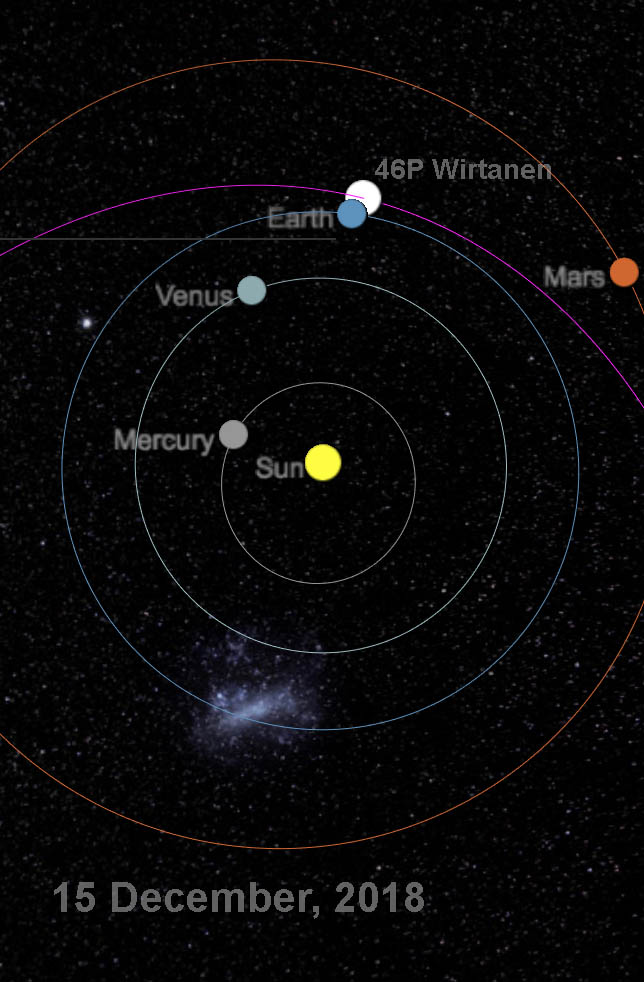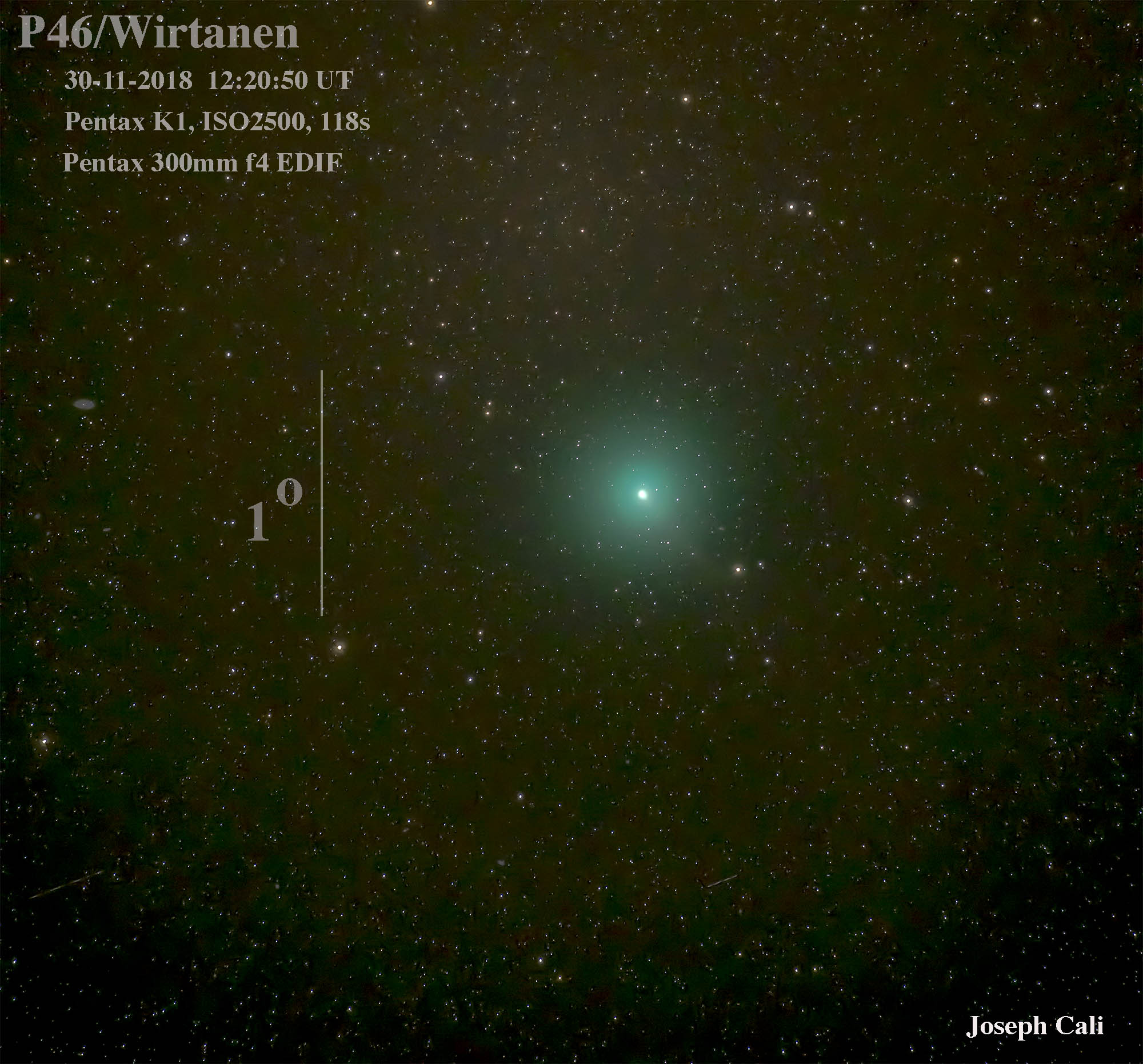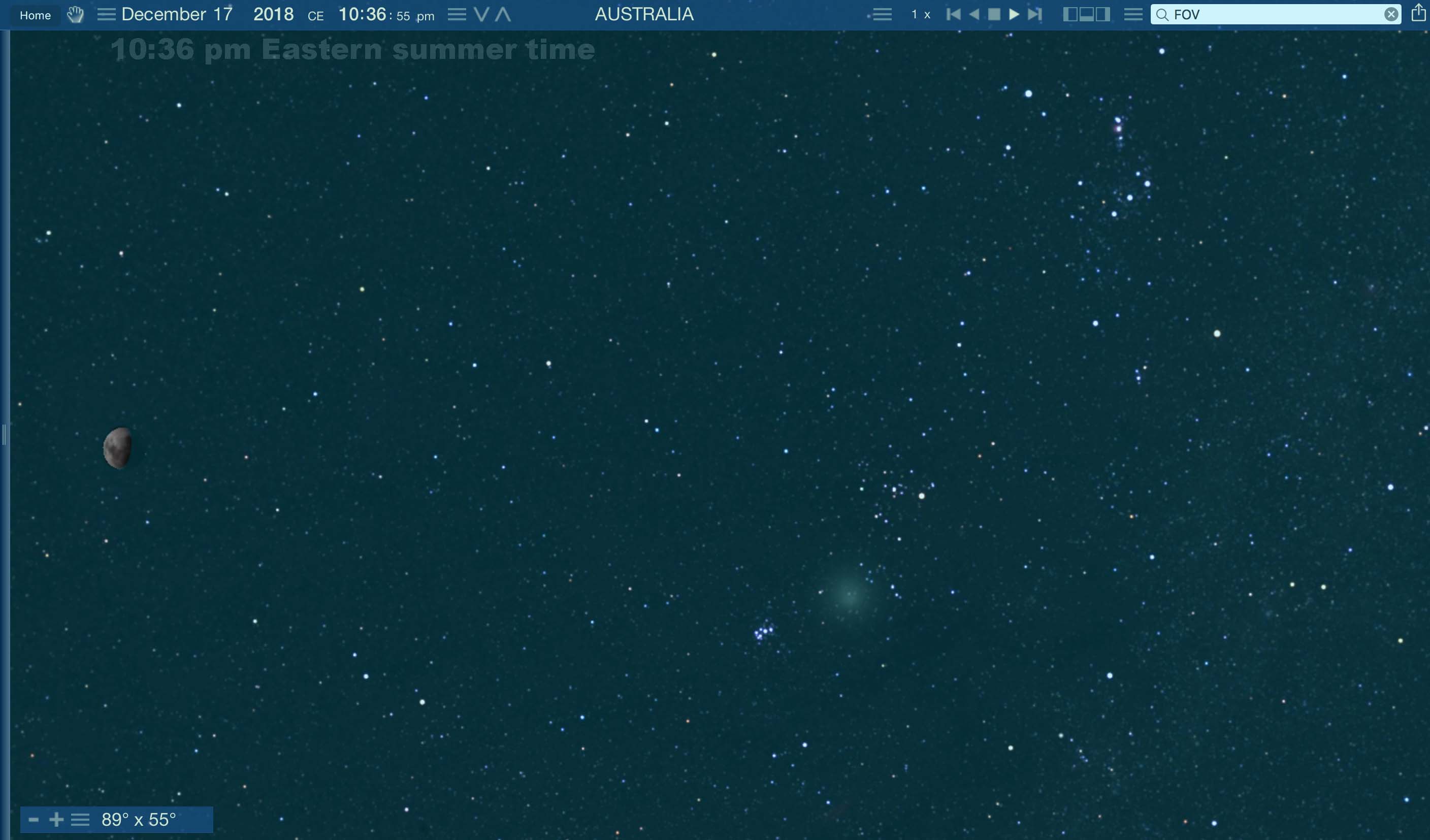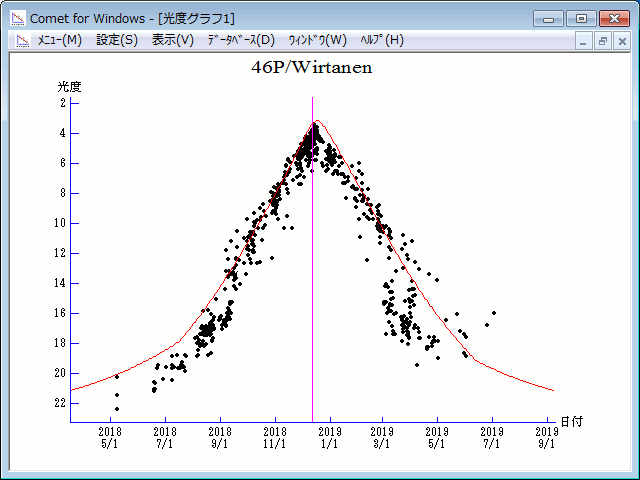| WAITING FOR THE SHADOW SOLAR AND LUNAR ECLIPSE & ASTRONOMICAL OBSERVING - Joe Cali |
| PHOTOGRAPHY | ECLIPSES | ASTRONOMY | HOME PAGE |
 |
In the final months of 2018, Earth will experience what is probably the finest apparition of periodic comet (46P) Wirtanen of the 20th and 21st centuries. Carl A Wirtanen discovered 46P/Wirtanen at Lick in 1948. It is in a chaotic orbit, and its perihelion distance was much reduced due to approaches to Jupiter in 1972 and 84. 46P Wirtanen is a 1.2km diameter short period comet discovered photographically by Carl Wirtanen at Lick Observatory in 1948. Wirtanen is a Jupiter group comet that has a period of 5.43 years and aphelion of 5.1 AU. Perihelion is 1.05 AU and the orbit passes very close to the Earths orbit each perihelion. Perihelion passage grazes that part of the Earth's orbit that the Earth occupies in November-December each year. If perihelion occurs at other parts of the year, as occurs most passages, the comet is quite distant from Earth and therefore faint. This year, perigee occurs in November-December as the comet passes just 11.1 million km or 0.08AU from the Earth. Using orbital calculators, this appears to be the closest approach since discovery and for the rest of this century. Use 3D viewers to visualise the orbit and the close passage to Earth?
|
| Recent Observations & Photo's Comet 46P/Wirtanen Photo Gallery Visual observations 11 November I observed the comet visually prior to taking the photograph below on the evening of November 8 from dark skies north of Yass NSW. Seeing wasn't great but transparency was outstanding. The Milky Way through Taurus, Orion and The comet was visible as a faint patch in the 8x50mm finder scope. It was much more obvious in my 9x63mm binoculars. In my 8" cassegrain, an extended coma is visible, but the comet doesn't take well to magnification. Use the lowest magnification biggest exit pupil you can manage with your scope. My 200mm f/9 cassegrain showed it best with a 31mm Nagler (60x, 3.5mm exit pupil) and a 42mm Superview (45x, 4.5mm exit pupil). 16 November With an interfering Moon, observations more difficult than on the 11 Nov. 30 November After a break due to full Moon and a week of cloud, the comet has brightened considerably. On arriving at my Bortle 1/2 site at Astronomical twilight, there were broken low level clouds covering 40% of the sky. The weather forecasting model we use for this area predicted a complete clearing soon after astro twilight. The clearing came about half an hour late. So I set up the mount, photographic polar alignment only takes about 5 mins using my APPS tool and then the camera was happily shooting away. While the camera was taking 2 min subs of the comet, I made a series of binocular and naked eye observations. The comet was faint and indistinct to the naked eye in my Bortle 1-2 skies so don't expect to see it pop out from urban skies this weekend. However, I repeated a test where I would eyeball the faint fuzzy patch naked eye without star hopping, then lift 7x35mm binos to my eyes to confirm I was indeed detecting the comet. The image below was taken on December 02, 2018. The image below was taken on November 30th using a Pentax K1 DSLR ISO800 2 mins Pentax 300mm f4 EDIF lens. Single image.  |

| 2018 Apparition Visibility of this apparition is pretty equally favourable between north and south hemispheres. During October and November, the southern hemisphere gets prime view. At perigee in mid December, the comet is visible to both hemispheres. Mid-southern latitudes will lose sight of the comet before Christmas eve. North Queensland members may see it a little longer before it moves to far north declinations. Though the north hemisphere gets to see it post perigee, the full and waning Moon will interfere with observations for our northern friends from December 21 onwards through full Moon and until the Moon's crescent is small enough in January not to cause problems. Telescope owners may find it's worth observing and tracking the brightening of the comet from late October onwards when it will be an easy telescopic, and faint binocular comet. In mid-December, expect to possibly see a 3.5 magnitude fuzzy ball, 1-2 degrees diameter, not much of an ion tail (it's pointing away from us) passing between the Hyades and the Pleiades before disappearing over the north horizon. A waxing gibbous Moon will partly interfere with our mid-December observations. This comet's perigee passes outside the Earth's orbit effectively at opposition, which results in the comet transiting at midnight. Maximum brightness occurs around 1st quarter Moon (Dec 15). There are dark sky observing windows in the pre-dawn hours between midnight moonset and twilight reducing to nothing by December 21st. Even at last quarter Moon on December 15th, the Moon will set with the comet still high in the sky up to and around last quarter. Table 1 shows the visibility for SE Qld of the comet with respect to the Moon. Light blue indicates an interfering bright Moon, dark blue a dark sky observing window after moonset and before twilight. I have also included a column indicating the moonless hours of each night when the comet is up. Tail The comet pretty much remains at midnight opposition all through perigee/perihelion. Consequently, the tail will be pointing away from us all through this period. The comet's appearance will be that of a large symmetrical fuzzy ball as I have illustrated in the December 17 illustration above. Magnitude predictions Magnitude estimates from the NASA HORIZONS web interface indicate a maximum magnitude of about 9 in December. The comet is already this bright in October. The magnitude estimates presented here come from Seiichi Yoshida’s Bright Comet Web page. The two sites use quite different methods to determine brightness. HORIZONS uses a standard IAU formula based upon averages taken across many different comets including those that disappoint. This comet's brightness comes from proximity not anticipated outbursts. Yoshida has developed a brightness curve based on past observations of this comet. I think this method is more reliable. Observational brightness estimates in mid-October placed the comet at mag 9-9.5 and already following Yoshida's calculated brightness curve not the HORIZONS estimates. |

| Path of comet 46P Wirtanen - October 1st - December 16th Click on the map to link to a higher resolution image suitable for printing. |
Path of comet 46P Wirtanen - December 2nd - December 24th Click on the map to link to a higher resolution image suitable for printing. |
 |
 |
 |
 |
| Comet 46P Wirtanen Ephemeris October 1 - December 30, 2018. ******************************************************************************* Ephemeris / WWW_USER Fri Sep 28 14:13:26 2018 Pasadena, USA / Horizons ******************************************************************************* Target body name: 46P/Wirtanen {source: JPL#K182/7} Center body name: Earth (399) {source: DE431} Center-site name: Mount Stromlo ******************************************************************************* Start time : A.D. 2018-Oct-01 00:00:00.0000 UT Stop time : A.D. 2018-Dec-30 00:00:00.0000 UT Step-size : 2880 minutes ******************************************************************************* Target pole/equ : No model available Target radii : 0.6 km Center geodetic : 149.007700,-35.320485,0.7379299 {E-lon(deg),Lat(deg),Alt(km)} Center cylindric: 149.007700,5210.55368,-3667.362 {E-lon(deg),Dxy(km),Dz(km)} Center pole/equ : High-precision EOP model {East-longitude positive} Center radii : 6378.1 x 6378.1 x 6356.8 km {Equator, meridian, pole} Target primary : Sun Vis. interferer : MOON (R_eq= 1737.400) km {source: DE431} Rel. light bend : Sun, EARTH {source: DE431} Rel. lght bnd GM: 1.3271E+11, 3.9860E+05 km^3/s^2 Small-body perts: Yes {source: SB431-N16} Atmos refraction: NO (AIRLESS) RA format : HMS Time format : CAL EOP file : eop.180927.p181219 EOP coverage : DATA-BASED 1962-JAN-20 TO 2018-SEP-27. PREDICTS-> 2018-DEC-18 Units conversion: 1 au= 149597870.700 km, c= 299792.458 km/s, 1 day= 86400.0 s Table cut-offs 1: Elevation (-90.0deg=NO ),Airmass (>38.000=NO), Daylight (NO ) Table cut-offs 2: Solar elongation ( 0.0,180.0=NO ),Local Hour Angle( 0.0=NO ) Table cut-offs 3: RA/DEC angular rate ( 0.0=NO ) ******************************************************************************* Initial IAU76/J2000 heliocentric ecliptic osculating elements (au, days, deg.): EPOCH= 2458340.5 ! 2018-Aug-10.0000000 (TDB) RMSW= n.a. EC= .6585259788502387 QR= 1.055358505144482 TP= 2458465.4292987557 OM= 82.16371401356682 W= 356.3305624789888 IN= 11.74555778842221 Equivalent ICRF heliocentric equatorial cartesian coordinates (au, au/d): X= 1.741904313395499E+00 Y=-3.294591735595458E-01 Z=-5.500008120018625E-01 VX=-4.566880361446887E-03 VY= 1.245567671525117E-02 VZ= 6.862923545190293E-03 Comet physical (GM= km^3/s^2; RAD= km): GM= n.a. RAD= .600 M1= 14.6 M2= 16.9 k1= 12. k2= 5. PHCOF= .030 ************************************************************************************************************** Date__(UT)__HR:MN R.A._(ICRF/J2000.0)_DEC T-mag N-mag delta deldot S-O-T /r S-T-O ************************************************************************************************************** $$SOE 2018-Oct-01 00:00 * 01 53 44.22 -26 12 54.1 14.82 16.79 0.47923355883090 -13.7373841 144.1364 /L 24.4417 2018-Oct-03 00:00 *m 01 54 32.08 -26 48 45.1 14.69 16.71 0.46329963580975 -13.3396175 143.8742 /L 24.8899 2018-Oct-05 00:00 *m 01 55 14.77 -27 24 20.5 14.56 16.63 0.44782799111086 -12.9538105 143.5122 /L 25.4104 2018-Oct-07 00:00 *m 01 55 52.42 -27 59 28.0 14.42 16.55 0.43280439473928 -12.5813365 143.0546 /L 26.0025 2018-Oct-09 00:00 *m 01 56 25.27 -28 33 54.3 14.29 16.47 0.41821260377115 -12.2242425 142.5068 /L 26.6644 2018-Oct-11 00:00 *m 01 56 53.67 -29 07 25.4 14.16 16.39 0.40403378467662 -11.8848215 141.8755 /L 27.3934 2018-Oct-13 00:00 *m 01 57 18.08 -29 39 47.0 14.02 16.31 0.39024660223444 -11.5649744 141.1681 /L 28.1859 2018-Oct-15 00:00 *m 01 57 39.02 -30 10 44.5 13.89 16.24 0.37682789661917 -11.2659006 140.3929 /L 29.0377 2018-Oct-17 00:00 * 01 57 57.06 -30 40 03.5 13.75 16.16 0.36375345855479 -10.9882027 139.5589 /L 29.9436 2018-Oct-19 00:00 * 01 58 12.84 -31 07 29.1 13.62 16.09 0.35099859440639 -10.7320906 138.6753 /L 30.8984 2018-Oct-21 00:00 * 01 58 27.04 -31 32 46.0 13.48 16.02 0.33853851599908 -10.4974648 137.7516 /L 31.8959 2018-Oct-23 00:00 * 01 58 40.40 -31 55 38.9 13.34 15.95 0.32634871910135 -10.2838616 136.7975 /L 32.9300 2018-Oct-25 00:00 * 01 58 53.71 -32 15 51.6 13.21 15.87 0.31440546603230 -10.0903495 135.8227 /L 33.9939 2018-Oct-27 00:00 * 01 59 07.80 -32 33 07.2 13.07 15.80 0.30268634445438 -9.9155288 134.8371 /T 35.0806 2018-Oct-29 00:00 * 01 59 23.58 -32 47 07.4 12.93 15.73 0.29117070179190 -9.7577541 133.8505 /T 36.1826 2018-Oct-31 00:00 *m 01 59 42.07 -32 57 32.1 12.79 15.65 0.27983972585223 -9.6154876 132.8734 /T 37.2920 2018-Nov-02 00:00 *m 02 00 04.45 -33 03 58.6 12.65 15.57 0.26867615988783 -9.4875382 131.9163 /T 38.3999 2018-Nov-04 00:00 *m 02 00 32.11 -33 06 02.1 12.50 15.49 0.25766387802669 -9.3730603 130.9906 /T 39.4966 2018-Nov-06 00:00 *m 02 01 06.63 -33 03 14.9 12.36 15.41 0.24678758655801 -9.2713448 130.1081 /T 40.5718 2018-Nov-08 00:00 *m 02 01 49.83 -32 55 06.7 12.22 15.33 0.23603286443410 -9.1814503 129.2817 /T 41.6138 2018-Nov-10 00:00 *m 02 02 43.66 -32 41 03.5 12.07 15.24 0.22538666881142 -9.1018018 128.5248 /T 42.6100 2018-Nov-12 00:00 *m 02 03 50.22 -32 20 27.2 11.92 15.14 0.21483821591083 -9.0299746 127.8524 /T 43.5461 2018-Nov-14 00:00 *m 02 05 11.76 -31 52 33.1 11.77 15.04 0.20437996324761 -8.9627199 127.2807 /T 44.4063 2018-Nov-16 00:00 * 02 06 50.67 -31 16 28.6 11.61 14.93 0.19400850211831 -8.8960560 126.8281 /T 45.1720 2018-Nov-18 00:00 * 02 08 49.53 -30 31 10.2 11.45 14.82 0.18372539851046 -8.8252424 126.5158 /T 45.8219 2018-Nov-20 00:00 * 02 11 11.17 -29 35 20.5 11.29 14.69 0.17353816615420 -8.7445705 126.3683 /T 46.3308 2018-Nov-22 00:00 * 02 13 58.70 -28 27 24.1 11.13 14.56 0.16346157875351 -8.6469912 126.4147 /T 46.6686 2018-Nov-24 00:00 * 02 17 15.58 -27 05 22.8 10.96 14.41 0.15351945368316 -8.5236917 126.6897 /T 46.7994 2018-Nov-26 00:00 * 02 21 05.78 -25 26 48.9 10.79 14.26 0.14374686359679 -8.3637898 127.2350 /T 46.6798 2018-Nov-28 00:00 * 02 25 33.95 -23 28 38.6 10.61 14.08 0.13419262602755 -8.1541005 128.1010 /T 46.2572 2018-Nov-30 00:00 *m 02 30 45.64 -21 07 05.6 10.43 13.89 0.12492219488655 -7.8785807 129.3481 /T 45.4688 2018-Dec-02 00:00 *m 02 36 47.54 -18 17 37.5 10.25 13.69 0.11602148682695 -7.5172656 131.0466 /T 44.2415 2018-Dec-04 00:00 *m 02 43 47.54 -14 54 58.0 10.07 13.47 0.10760202618574 -7.0451449 133.2739 /T 42.4944 2018-Dec-06 00:00 *m 02 51 54.93 -10 53 24.1 9.90 13.23 0.09980702470592 -6.4318204 136.1054 /T 40.1475 2018-Dec-08 00:00 *m 03 01 20.30 -06 07 29.7 9.73 12.97 0.09281683269212 -5.6432183 139.5954 /T 37.1408 2018-Dec-10 00:00 *m 03 12 15.50 -00 33 35.0 9.58 12.72 0.08685033302931 -4.6473572 143.7369 /T 33.4726 2018-Dec-12 00:00 *m 03 24 53.23 +05 47 51.4 9.45 12.47 0.08215637104554 -3.4262305 148.3933 /T 29.2662 2018-Dec-14 00:00 * 03 39 26.20 +12 49 20.5 9.37 12.25 0.07898821728409 -1.9929576 153.1949 /T 24.8688 2018-Dec-16 00:00 * 03 56 05.60 +20 14 32.6 9.33 12.10 0.07755885732546 -0.4060657 157.4267 /T 20.9559 2018-Dec-18 00:00 * 04 14 58.66 +27 39 39.5 9.35 12.04 0.07798853919281 1.2336292 160.0625 /T 18.4952 2018-Dec-20 00:00 * 04 36 05.15 +34 38 43.2 9.42 12.10 0.08027018794632 2.8106108 160.3314 /T 18.2070 2018-Dec-22 00:00 * 04 59 13.51 +40 50 23.3 9.54 12.25 0.08427438649982 4.2320639 158.5335 /T 19.8033 2018-Dec-24 00:00 * 05 23 57.93 +46 02 19.6 9.70 12.47 0.08979045197371 5.4500848 155.6958 /T 22.3181 2018-Dec-26 00:00 * 05 49 38.32 +50 11 32.2 9.88 12.72 0.09657865503110 6.4594726 152.6642 /T 24.9616 2018-Dec-28 00:00 *m 06 15 24.78 +53 21 57.4 10.07 12.97 0.10441047529878 7.2816809 149.8739 /T 27.3329 2018-Dec-30 00:00 *m 06 40 25.75 +55 41 24.4 10.27 13.21 0.11308945190670 7.9487627 147.4895 /L 29.2867 $$EOE ************************************************************************************************************** Column meaning: TIME Prior to 1962, times are UT1. Dates thereafter are UTC. Any 'b' symbol in the 1st-column denotes a B.C. date. First-column blank (" ") denotes an A.D. date. Calendar dates prior to 1582-Oct-15 are in the Julian calendar system. Later calendar dates are in the Gregorian system. Time tags refer to the same instant throughout the solar system, regardless of where the observer is located. For example, if an observation from the surface of another body has an output time-tag of 12:31:00 UTC, an Earth-based time-scale, it refers to the instant on that body simultaneous to 12:31:00 UTC on Earth. The Barycentric Dynamical Time scale (TDB) is used internally as defined by the planetary equations of motion. Conversion between TDB and the selected non-uniform UT output time-scale has not been determined for UTC times after the next July or January 1st. The last known leap-second is used as a constant over future intervals. NOTE: "n.a." in output means quantity "not available" at the print-time. SOLAR PRESENCE (OBSERVING SITE) Time tag is followed by a blank, then a solar-presence symbol: '*' Daylight (refracted solar upper-limb on or above apparent horizon) 'C' Civil twilight/dawn 'N' Nautical twilight/dawn 'A' Astronomical twilight/dawn ' ' Night OR geocentric ephemeris LUNAR PRESENCE (OBSERVING SITE) The solar-presence symbol is immediately followed by a lunar-presence symbol: 'm' Refracted upper-limb of Moon on or above apparent horizon ' ' Refracted upper-limb of Moon below apparent horizon OR geocentric ephemeris R.A._(ICRF/J2000.0)_DEC = Astrometric right ascension and declination of the TARGET CENTER with respec to the observing site in the coordinates of the ICRF/J2000 inertial reference frame. Compensated for down-leg light-time. Units: RA in hours-minutes-seconds of time (HH MM SS.ff), DEC in angular degrees-minutes-seconds (DD MM SS.f) T-mag N-mag = Comet's approximate apparent visual total magnitude ("T-mag") and nuclear magnitude ("N-mag") by following standard IAU definitions: T-mag = M1 + 5*log10(delta) + k1*log10(r) N-mag = M2 + 5*log10(delta) + k2*log10(r) + phcof*beta Units: MAGNITUDES delta deldot = Range ("delta") and range-rate ("delta-dot") of target center with respect to the observer at the instant light seen by the observer at print-time would have left the target center (print-time minus down-leg light-time); the distance traveled by a light ray emanating from the center of the target and recorded by the observer at print-time. "deldot" is a projection of the velocity vector along this ray, the light-time-corrected line-of-sight from the coordinate center, and indicates relative motion. A positive "deldot" means the target center is moving away from the observer (coordinate center). A negative "deldot" means the target center is moving toward the observer. Units: AU and KM/S S-O-T /r = Sun-Observer-Target angle; target's apparent SOLAR ELONGATION seen from the observer location at print-time. Angular units: DEGREES The '/r' column indicates the target's apparent position relative to the Sun in the observer's sky, as described below: For an observing location on the surface of a rotating body (considering its rotational sense): /T indicates target TRAILS Sun (evening sky; rises and sets AFTER Sun) /L indicates target LEADS Sun (morning sky; rises and sets BEFORE Sun) For an observing point NOT on a rotating body (such as a spacecraft), the "leading" and "trailing" condition is defined by the observer's heliocentric orbital motion: if continuing in the observer's current direction of heliocentric motion would encounter the target's apparent longitude first, followed by the Sun's, the target LEADS the Sun as seen by the observer. If the Sun's apparent longitude would be encountered first, followed by the target's, the target TRAILS the Sun. NOTE: The S-O-T solar elongation angle is numerically the minimum separation angle of the Sun and target in the sky in any direction. It does NOT indicate the amount of separation in the leading or trailing directions, which are defined in the equator of a spherical coordinate system. S-T-O = "S-T-O" is the Sun->Target->Observer angle; the interior vertex angle at target center formed by a vector to the apparent center of the Sun at reflection time on the target and the apparent vector to the observer at print-time. Slightly different from true PHASE ANGLE (requestable separately) at the few arcsecond level in that it includes stellar aberration on the down-leg from target to observer. Units: DEGREES Computations by ... Solar System Dynamics Group, Horizons On-Line Ephemeris System 4800 Oak Grove Drive, Jet Propulsion Laboratory Pasadena, CA 91109 USA Information: http://ssd.jpl.nasa.gov/ Connect : telnet://ssd.jpl.nasa.gov:6775 (via browser) telnet ssd.jpl.nasa.gov 6775 (via command-line) Author : Jon.D.Giorgini@jpl.nasa.gov ************************************************************************************************************** |
| PHOTOGRAPHY | ECLIPSES | ASTRONOMY | HOME PAGE |